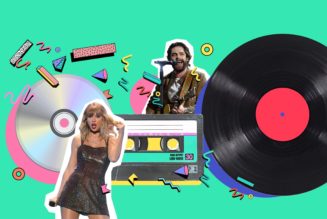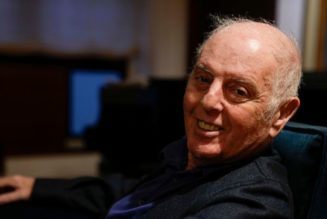
In music therapy, clients play and listen to music as treatment for stress, depression and anxiety. Here’s how it works.
The therapy session begins when Isobell, 17, picks up a guitar.
Her fingers, adorned with silver rings and black nail polish, are positioned to play the first chord of Lana Del Rey’s “Candy Necklace.”
Then she starts to sing, her voice a melancholy, breathy soprano that seems to float across the room.
White noise coming out of my brain
Turns off for nothing
Isobell’s therapist, Caitlin Bell, accompanies her on the piano.
Although they are actually sitting in a medical clinic — the Louis Armstrong Center for Music and Medicine at Mount Sinai-Union Square in Manhattan — the space feels more like a musician’s living room, with sheet music on display and wooden bookcases that line the walls, each housing different instruments.
Music therapy, while still a relatively small field, has grown over the last decade. The practice helps people cope with ailments as wide-ranging as stress, chronic pain, limited mobility and hypertension, and is performed in a variety of settings, including psychiatric hospitals, outpatient clinics, senior centers and schools.
Scientific research has begun to explore why music appears to have such a strong effect on health and wellness, particularly mental health, where sounds can serve as a conduit to lift someone’s mood, help them reflect and reduce stress, anxiety and depression.
When she was 14, Isobell’s treatment for anxiety looked very different. At the time, she was seeing a psychiatrist. But after trying two different medications, she felt that they “weren’t really doing anything.”
She was starting to feel discouraged, until her doctor — knowing that she loved to play the guitar and write songs — recommended that she try music therapy.
For the past two years, she has traveled to Mount Sinai nearly every week, despite her packed schedule as a senior at one of the most selective public high schools in New York City.
Isobell, who asked to be referred to only by her first name to protect her privacy, no longer takes medication.
Singing creates space to release emotions that can be difficult to describe, she explained.
Even just listening to a song and interpreting the meaning “opens up so much in my mind,” she added. “I feel like I always draw a blank when people ask me, ‘What’s up? What’s going on?’” But music therapy helps her become more introspective.
Here’s a look at how music therapy is used as a psychotherapy tool.
How can music therapy improve mental health?
Research has shown that adding music therapy to a patient’s regular treatment, like medication and psychotherapy, can improve depressive symptoms when compared with standard treatment alone. Studies also indicate that music therapy can decrease anxiety levels and improve day-to-day functioning in people with depression.
More studies are needed to better understand why, but scientists do know that music engages multiple regions of the brain, like the limbic system, which helps process emotions and recollections. This may be partly why music is known to bring back memories.
Seeking to explore that connection, Amy Belfi, an associate professor at the Missouri University of Science and Technology, designed a study that compared the memories evoked by popular songs with those summoned by images of celebrities. She found that the music was much more likely to bring up vivid autobiographical details than the images.
“I think music is able to bring about these emotional responses that then also facilitate the memory retrieval,” Dr. Belfi said, which may explain why music therapy can help improve cognition and quality of life in people with dementia.
Different studies have found that music affects our bodies in other ways as well. Fast tempos can be arousing; and slow or meditative music may help people relax.
In addition, both listening to music and singing can reduce levels of cortisol, a hormone that the body releases when it is under stress. And the pleasure we feel when listening to music can produce dopamine, a neurotransmitter that influences the reward centers in the brain.
Finally, because music therapy is so interactive — clients will often play instruments with their therapist or write lyrics together — it allows for self-expression both individually and in a communal setting, said Kenneth Aigen, the director of music therapy at the NYU Steinhardt School of Culture, Education and Human Development.
Music has been a driving force throughout Dr. Aigen’s life — for the past 14 years, he has played keyboard in a Grateful Dead tribute band. He said he wants his clients to discover the power of communing and collaborating with other people through music, just as he has, either in group sessions or one-on-one meetings with a therapist.
“When you join with other human beings through music, there’s no other experience like it,” he said. “I think it completely changes how you think of yourself.”
For Kerry Devlin, a senior music therapist who works with critically ill patients at the Johns Hopkins Hospital in Baltimore, music is a therapeutic tool to share space with people during some of the worst moments of their lives.
A session can give patients a sense of autonomy and help them become “reconnected with their own humanity in what often feels like a really sterile and scary environment,” Ms. Devlin said.
When providing palliative care, for example, she uses a special stethoscope to record a patient’s heartbeat, then works with the person and sometimes also their family to select a meaningful song and add personalized lyrics or harmonies. “We use that person’s heartbeat as the rhythmic pulse,” she said. “This is a piece of their life, recorded forever and ever, which is such a gift.”
How did music therapy originate?
Music has created community and helped people achieve catharsis since ancient times, but music therapy did not become a profession until more recently. According to the American Music Therapy Association, the earliest known reference to music therapy appears in a magazine that was published in the late 1780s. It didn’t become an organized profession until much later in the mid-1900s. Today, there are about 10,000 providers who have become board-certified in music therapy.
Some states may have additional requirements.
What are the misconceptions about music therapy?
When Ms. Devlin arrives for her sessions — a guitar strapped across her back, wheeling a cart full of instruments — some people assume that they need to be musically gifted or proficient at playing an instrument in order to participate.
But that’s not the case.
“We might wail on a drum together or we might give them something that really vibrates and provides a grounding sensation to help them connect with their body and their breath,” she said. “There isn’t such a thing as a wrong note.”
Others prefer to listen to music rather than create it. It’s up to the patient to decide what feels right.
Another myth about music therapy is that the providers function as entertainers. While music can be fun, a music therapist is not performing for an audience but rather using therapeutic techniques to help their clients meet goals, express their emotions and share their creativity.
Where do you find a music therapist?
Email or call the A.M.T.A. or search its online directory for music therapists in your area.
Insurance companies often do not include music therapists in their panel of providers, however, you may be able to get reimbursed for some of your out-of-network costs.
Ms. Devlin also suggested searching online for resources in your area. The music therapy offered by Johns Hopkins in Baltimore, for example, is free of charge, including the support groups.









